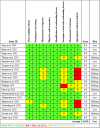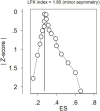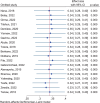Dietary knowledge, attitude, practice, and associated factors among pregnant mothers in Ethiopia: a systematic review and meta-analysis
- PMID: 39328997
- PMCID: PMC11425043
- DOI: 10.3389/fpubh.2024.1393764
Dietary knowledge, attitude, practice, and associated factors among pregnant mothers in Ethiopia: a systematic review and meta-analysis
Abstract
Background: Despite global efforts, progress in reducing maternal malnutrition falls short of international goals, which is the same for Ethiopia, provided that studying dietary knowledge, attitude, and practice and their determinants is crucial to developing and implementing effective interventions, which this review tried to investigate in an Ethiopian context.
Methods: We searched on Scopus, HINARI, PubMed, and Google Scholar on January 3, 2024. We used the Joanna Briggs Institute's (JBI's) tools and the "preferred reporting items for systematic reviews and meta-analyses (PRISMA) 2020 statement" to evaluate bias and frame the review, respectively. The data were analyzed using Stata 17. Certainty was assessed using sensitivity and subgroup analyses and the Luis Furuya-Kanamori (LFK) index. The random effects model was used to determine the effect estimates with a p value less than 0.05 and a 95% CI.
Results: The pooled good dietary knowledge, favorable attitude, and good practice were 48.0% (95% CI: 39.0-57.0%), 47.0% (95% CI: 38.0-55.0%), and 34.0% (95% CI: 28.0-40.0%), respectively. Knowledge and attitude had bidirectional relationships and were affected by sociodemographic variables and gynecological issues. The dietary practice was influenced by urban residency (OR = 6.68, 95% CI: 2.49-10.87), food security (OR = 3.51, 95% CI: 1.02-5.99), knowledge (OR = 4.53, 95% CI: 3.22-5.74), nutrition information (OR = 3.07, 95% CI: 1.13-5.02), attitude (OR = 2.32, 95% CI: 1.34-3.30), family support (OR = 2.14, 95% CI: 1.43-2.85), perceived severity of malnutrition (OR = 2.07, 95% CI: 1.82-2.31), and positive perception of dietary benefit (OR = 2.19, 95% CI: 1.56-2.82).
Conclusion: The good dietary practice was lower than the knowledge and the favorable attitude toward it. It was influenced by sociodemographic variables, income and wealth, knowledge and information, attitudes and intentions, gynecological and illness experiences, family support and decision-making, and expectations of nutrition outcomes and habits. Sociodemographic and gynecological issues were also found to influence both dietary knowledge and attitude, which were also found to have bidirectional relationships.Systematic review registration: PROSPERO identifier: CRD42023440688.
Keywords: Ethiopia; attitude; diet; factor; knowledge; nutrition; practice; pregnancy.
Copyright © 2024 Bayked, Yimer, Gelaw, Mohammed and Mekonen.
Conflict of interest statement
The authors declare that the research was conducted in the absence of any commercial or financial relationships that could be construed as a potential conflict of interest.
Figures


















Similar articles
-
Knowledge, attitude, practice and associated factors of oxygen therapy among health professionals in Ethiopia: A systematic review and meta-analysis.PLoS One. 2024 Sep 6;19(9):e0309823. doi: 10.1371/journal.pone.0309823. eCollection 2024. PLoS One. 2024. PMID: 39240945 Free PMC article.
-
Knowledge, attitude and practice towards antenatal physical exercise among pregnant women in Ethiopia: A systematic review and meta-analysis.PLoS One. 2023 Dec 14;18(12):e0295275. doi: 10.1371/journal.pone.0295275. eCollection 2023. PLoS One. 2023. PMID: 38096224 Free PMC article.
-
Willingness to pay for National Health Insurance Services and Associated Factors in Africa and Asia: a systematic review and meta-analysis.Front Public Health. 2024 Apr 19;12:1390937. doi: 10.3389/fpubh.2024.1390937. eCollection 2024. Front Public Health. 2024. PMID: 38706546 Free PMC article.
-
Pregnant women's knowledge, attitude, and practice towards COVID-19 infection prevention in Ethiopia: A systematic review and meta-analysis.PLoS One. 2022 Oct 26;17(10):e0276692. doi: 10.1371/journal.pone.0276692. eCollection 2022. PLoS One. 2022. PMID: 36288349 Free PMC article.
-
Dietary diversity feeding practice and its associated factors among children age 6-23 months in Ethiopia from 2011 up to 2018: a systematic review and meta-analysis.Ital J Pediatr. 2018 Sep 17;44(1):109. doi: 10.1186/s13052-018-0567-9. Ital J Pediatr. 2018. PMID: 30223854 Free PMC article.
Cited by
-
Association of Dietary Patterns and Pre-pregnancy Body Mass Indices With Gestational and Birth Outcomes in Pregnant Emirati Women: A Cross-Sectional Study.Cureus. 2024 Dec 3;16(12):e75038. doi: 10.7759/cureus.75038. eCollection 2024 Dec. Cureus. 2024. PMID: 39749079 Free PMC article.
-
Dietary practice and associated factors among lactating mothers in Dangila District in the Awi Zone Amhara region Ethiopia, 2022: a cross-sectional study.Front Nutr. 2025 Jan 6;11:1506707. doi: 10.3389/fnut.2024.1506707. eCollection 2024. Front Nutr. 2025. PMID: 39834454 Free PMC article.
-
Dietary Habits and Nutritional Knowledge of Pregnant Women: The Importance of Nutrition Education.Foods. 2024 Oct 8;13(19):3189. doi: 10.3390/foods13193189. Foods. 2024. PMID: 39410224 Free PMC article. Review.
References
-
- Results UK (2021). Nutrition is a human right, Results UK, London, United Kingdom.
-
- Rannan-Eliya R.P. (2008). Extending social health protection in the Asia Pacific region: progress and challenges, International Labour Organization, New Delhi, India, 9–20.
-
- World Health Organization (2019). Nutrition in universal health coverage, World Health Organization.
-
- Centre for Health Protection (2017). Nutrient Classifications. Centre for Health Protection, Kowloon City, Hong Kong.
-
- Das JK, Salam RA, Bhutta ZA. Malnutrition: a global problem In: Guandalini S, Dhawan A, Branski D, editors. Textbook of Pediatric Gastroenterology, Hepatology and Nutrition: A Comprehensive Guide to Practice. Cham: Springer International Publishing; (2016). 505–13.
Publication types
MeSH terms
LinkOut - more resources
Full Text Sources

